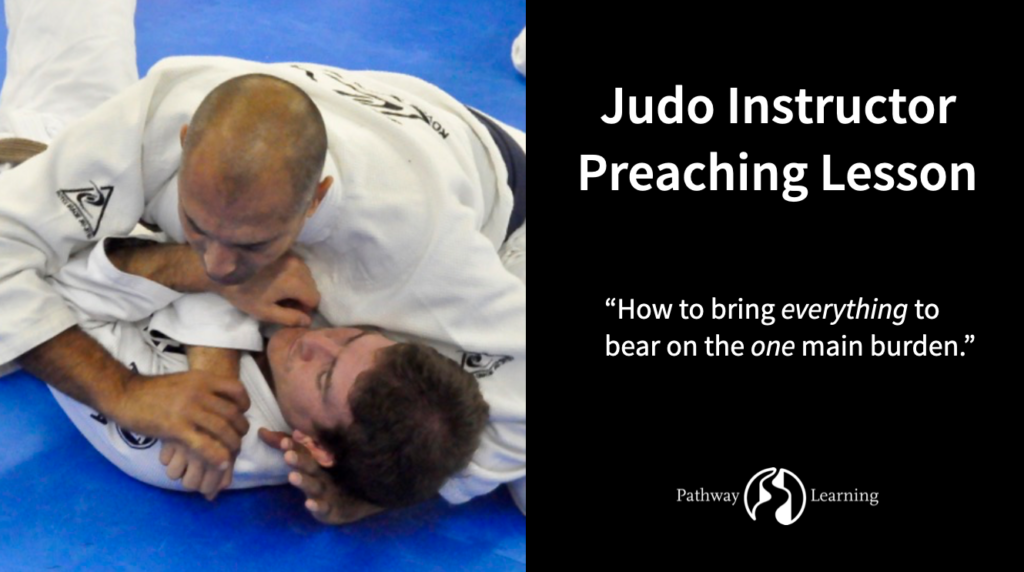Preaching Methods: Part 2 (Preaching, Part 5)
Series: Preaching (Part 5)
Author: Larry Kirk
Title: Preaching Methods: Part 2
You highlight and hone these things, your proposition, your explanations, your applications, your connection to Christ and the Gospel and how you will engage the heart. I'm using Bryan Chapell's terms, Chapell calls it the proposition. Some people call it the big idea, the burden of the passage, the theme, whatever you want to call it. Then if you base your outline off the proposition, if you relate everything in your outline to the proposition you've unified your sermon so that everything is pulling together towards that.
Years and years ago when I was younger I did jujitsu and judo. When you do a joint lock and I'm not a really big guy, right? If I was wrestling Jeff and I wanted to make him tap out what you want to do is I want to try to get him in one of those holds where I've got my legs over his head and I've got his arm reefed up across here and I'm holding it and then I'm not using my little puny arms against his guns but I'm using my hips, my butt, my back and my lats. I'm locking everything in and lifting my pelvis towards the sky so that I'm putting everything I've got to bear on that one joint. That's how a smaller guy can tap out a bigger guy.
In a sermon the idea of honing your proposition is that you have one key burden of the text and you want your introduction to introduce it, every point to develop it, every application so that you're tapping them out through the power of the Holy Spirit, through the message of the Gospel, by bringing everything to bear on that main burden of the passage. For instance in my 1 Peter passage when I studied it, there were 2 sentences and the first one said be subject to every human institution, the second one said, live as servants of God. Simple outline, be subject, be servants. What's the unifying idea? As followers of Jesus in a hostile culture we must be model citizens. How do we do that? By being subject, but by being servants, by living not just our primary category for confronting government and culture should not be red faced confrontation but Christ like service. How do we serve? How do we silence the ignorance of foolish men? By doing good works.
On the one hand we're subject to the government but we're also living as servants, as those who are free in Christ we live as servants of God. You try to bring everything to bear on that. Explanation is just how are you going to explain? So you don't just ramble on and spend 20 minutes on some Greek. How are you going to hone and highlight the things you need to explain? A word like propitiation or justification or sanctification or a concept. Then how are you going to highlight and hone your applications so that you think through what happens when you know it's easy to just say you should do this better, you should give more. What are the repercussions that people struggle with? Why aren't they giving more? How can I hone my application so that I help get at the motivation and help people do it better?
Chapell says there are 4 questions that you answer in the application. What? Where? Why? How? What is the text asking me to do? Where in our lives today does this actually confront us? Why should we do this? How do we find the strength and the power and the steps to do it?
Then C is connections to Christ and the Gospel. Where will I find maybe multiple places to make sure I'm playing the music as I go but also maybe there will be a significant place where I really want to turn up the music and orient people to the music so that, as I call them to apply this scripture to life I'm helping them see the relationship to Christ and the Gospel.
Then engaging the heart. How do I help get that tri-perspectival dynamic? How do I get beyond just data and application to the people? Taste the goodness ... Where the psalmist says taste and see that the Lord is good. It's not enough that people just know that the Lord is good. We're supposed to taste. How can I, not in a manipulative way, but in a legitimate way seek to reach the heart? It may be that in the introduction and in the conclusion or in illustrations that there are stories that I can legitimately tell that will help impact, help it get underneath the surface to where people connect with it in a bigger deeper way.
It may be just language. There may be places where I can use metaphors, simile or analogy or word pictures. It may just be in my own passion and or vulnerability that I tend to do with you guys step forward, get closer, lean in and go for the heart. We want to go for the heart. Think about where am I going to go for the heart in this?


